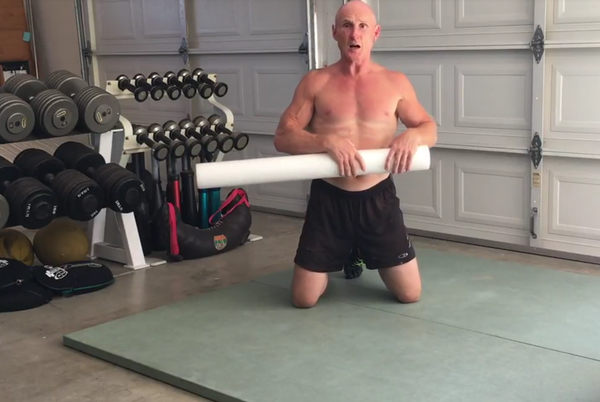
Happy Monday everybody!
Despite what I’ve been preaching for a long time, people still have a massive love affair with crunches and other sorts of abdominal exercises.
Too often, you’ll see people walking around with their abs flexed and thinking they look cool, but they don’t realize what that does to their ability to breathe naturally and how it disrupts circulation through their bodies.
If you experience too much tension in the abdomen, chest or hip flexors, this starts to disrupt the flow of energy throughout your body’s meridian system (the main system all of your other 12 major meridians branch out from), so you can get stagnant energy and your emotions will stay trapped in your body.
Your diet, your breathing and the movement of your diaphragm are among the key mechanisms that pump lymphatic fluid throughout your body to help it stay clean and deliver antibodies where they’re needed.
This week on my vlog, I’ll show you how to use a foam roller to help you free up your abdominal wall. In fact, I recommend that you do this every day, especially if you’re doing any hardcore conditioning.
Pay attention to these signs

As you use a foam roller, there’s some important things to keep in mind.
For starters, humans are the only animals in nature who have to pump fecal material uphill against gravity. Every other animal has a horizontal spine (a dog or a cat) or one like a horse or a chimpanzee that is partially up (although they also spend a lot of time more toward the horizontal).
In an upright human being, the ascending colon goes up on the right, the transverse colon comes across and the descending colon goes down on the left and hits the sigmoid colon, which is where it reaches out into the rectum.
You don’t want to roll the foam roller against the flow of the fecal material because it can pressurize the colon.
Many people have what’s called a diverticula or diverticulitis. Diverticula are like the little bulges you might see in a radiator hose or in the sidewall of a car tire that’s degenerating. If you pop one of those things, you can poison and kill yourself with sepsis. I’m not trying to scare the hell out of you. Just pay attention to what you’re feeling inside.
If you experience discomfort when you let the roller go inside your organs, you may ask if it’s muscular discomfort or visceral (meaning organ) discomfort.
Let’s say you’re doing the techniques that I’m showing you and you’re lying on the roller, then you feel a lot of sudden internal discomfort. Tighten your abdominal muscles like you’re flexing your muscles. If that increases the discomfort, that indicates you have a trigger point or some kind of soft tissue tenderness.
A decrease in tenderness isn’t good either
But what if the tenderness decreases as the abdominal wall tightens, acting like a spring that pushes the roller away from the organs?
If tightening the muscles alleviates the tenderness but relaxing increases it, you’ve probably got some kind of inflammation in that gland or organ and you want to be very, very gentle.
Be sure to go by what feels good. You want to nurture the body, and not beat it up. Incredibly, people do very stupid things — even with foam rollers — just like they do with everything from food and sex to money and power tools!

Having done this for many, many years and helping thousands of people with foam rolling, I’ve never had a single person pop a rib out and hurt themselves.
However, if you’re having significant problems with things like hormonal imbalances, severe menstrual irregularities or joint laxity, you may want to seek out guidance from a CHEK Professional before you do this.
Generally, a mobilization of the spine or ribs with a foam roller is just freeing it up. It’s not knocking it out. It’s just mobilizing it in the joint.
I could do multiple vlogs on ways to use a foam roller, but I want to focus this one on what I think is the most important issue to be aware of due to chronic ab flexing and tightening and the disruption it causes for breathing, lymphatic flow and emotional congestion and stagnation.
Resources
If you want to learn more, check out my book, How to Eat, Move and Be Healthy. It features 20 stretch tests that show you how to identify tension that needs to be addressed in the 20 most common muscles or muscle groups along with some mobilizations too.
If you want to go deeper, look at the Tennis Biomechanics Manual by Leigh Brandon and me, which has more length tension tests, mobilizations and Feldenkrais exercises. Also, my Golf Biomechanics Manual has a comprehensive section on stretching mobilization in neuromuscular mobilization techniques.
I hope you enjoy my vlog on using a foam roller to release your abdominal wall. Try it before you work out. Try it whenever you’re feeling emotionally trapped. Try it whenever you feel like you’d like to expand and open your breathing.
Couple that with some good Wim Hof training and you’ve really got something.

Love and chi,
Paul





